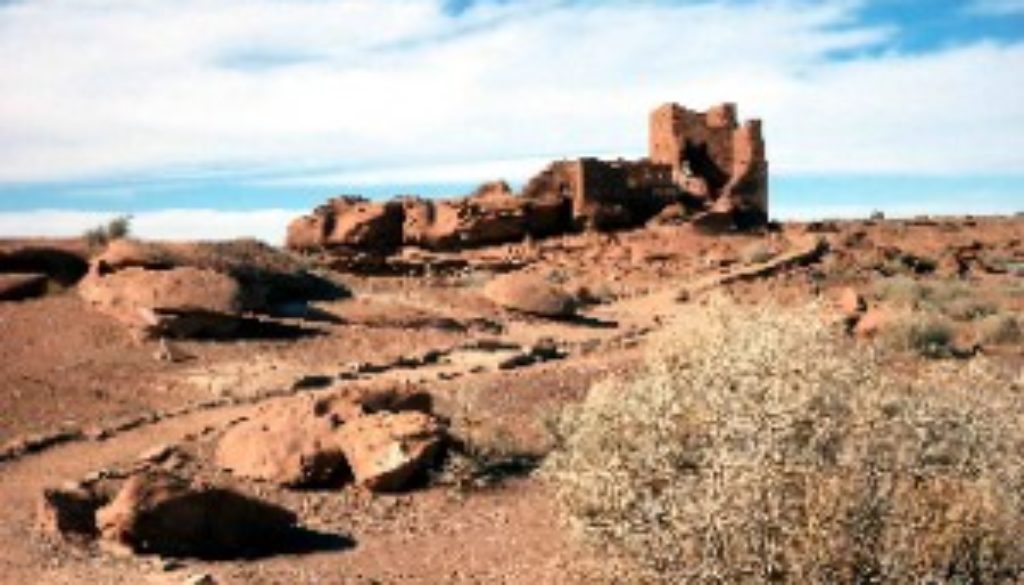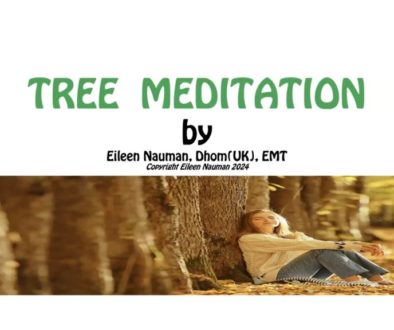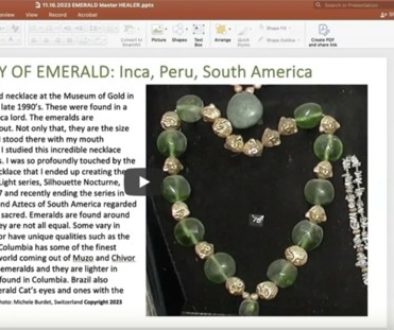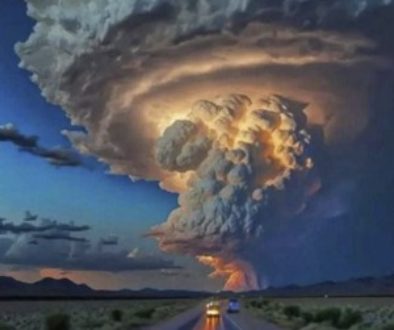Walking the Land: Wupatki Part II – Marchiene Rienstra
Copyright Marchiene Reinstra
2012
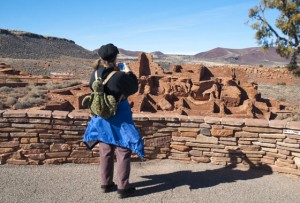
We travelled into the land of fire today. Driving up Oak Creek Canyon in the morning, we were talking of fire–the fire in Mother Earth, the fire that moves and melds in her molten core and sometimes spews up out of great openings in the Mother Earth’s mantle, leaving behind mountains of lava and ash and boulder-bombs, landscapes utterly changed by volcanic fire erupting suddenly.
The way fiery trials sometimes erupt in our lives…without warning, leaving their ash everywhere on the landscapes of our souls, driving us to seek new spaces and ways to live. Yet they leave behind, as volcanoes do, layers of ash that mix with the soil of our lives and turn it fertile in ways we could not have imagined, so that things grow out of that life landscape ravaged by fire which might otherwise never have burst out of their seed-casings.
And what of our world? we asked each other as we drove up the canyon beneath the watchful presence of red rock giants. It’s 2012. Does that mean anything, really?
Eileen thought the conjunction or squaring of Pluto and Uranus in these next three years might be more significant. (that’s her story to tell) “But if a global event,
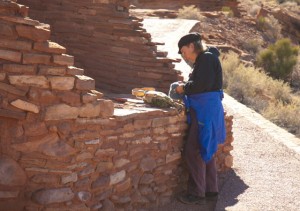
which might be viewed as a disaster, happens this year, or next, or the next,” she said, “a volcanic eruption feels the most likely. Almost all other kinds of sudden natural disaster are localized. A large volcanic eruption would change the globe and all life for humans overnight. And there are places right out West here that could blow any time–Yellowstone, and Long Valley in California, among them.”
With that sobering thought, we stopped for coffee and breakfast in Flagstaff, and noticed a clan of crows encouraging us on our way as we exited the coffee shop.
The day was domed with bright blue sky, and mild temperatures–unusual for January in the Flagstaff area.
As we took the highway east and north towards our destination–Sunset Crater and Wupatki National Monuments, we saluted the great Grandmothers towering over the landscape (aka the San Francisco Peaks–which are still part of an active volcanic field according to geologists) and admired their snowy gray hair-peaks as we drove along.
Eileen educated me on the symbolic meanings of the colors we would be seeing: reds, blacks, and browns would reflect feminine energies; whites male energies, and grays androgynous energies. (she will say more on this topic in her blog)
We easily found our way to the road that led to Sunset Crater area. After a brief stop at the Visitor Center, we took the narrow winding road that led past the lava fields and allowed for several places to stop and view the awesome evidence of the volcanic eruption that happened in this area a thousand years ago.
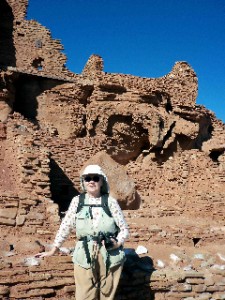
The terrain around us was largely black until we got past the Sunset Crater area and approached Wupatki.
We learned at the Visitor Center that this was a large area, more than 50 miles square, and contained several pueblo ruins scattered in many places miles apart.
We decided to begin with the major Wupatki pueblo right near the Visitor’s Center.
We stopped by a large guardian Cedar Tree to ground ourselves, make our offerings, and ask permission to enter and work with the land.
Having received it, we both immediately noticed the deep silence and sense of peace that wrapped the area in a sense of the sacred.
And Eileen knew she had come home, and memories of a life time in this place began to come into her mind.
I did not have the same feeling that I had lived there, but it did feel familiar somehow.
We walked along the loop pathway that skirted the buildings, a couple circular areas called community meeting places, and then went down the walk towards a “ball court” and “blow hole.”
That turned out to be a highlight of our whole trip!
“That is not a ball court!” exclaimed Eileen as she viewed it from the pathway. “It’s not a circle or a square, it’s womb shaped.”
She was right. We were able to walk up to it, and then into it…which we did. Immediately we both felt a very special energy there and Eileen said, “this was a ceremonial gathering place!” I had the same feeling.
I walked to the opening on the far end of the womb shaped area, which was enclosed by a low wall. The openings were aligned east and west.
We both felt drawn to stand at the west opening and meditate. I took out my flute and played a long song on it. The felt a great sadness come over me as I thought of the people who had lived here long ago, and how not only they but their whole way of life had vanished into the desert dust.
I decided to try to shake off the sadness by investigating the “blow hole.” It was a hole deep down into the earth, enclosed by a small square stone enclosure.
I could kneel down and place my face over the hole and feel a strong breeze blowing from deep down in Mother Earth.
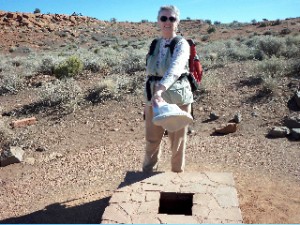
Mother Earth’s breath! It felt sacred to me, very special, and I stayed there quite a while, breathing in that holy breath and breathing my breath, exchanging breath with Mother Earth. I had a vivid vision of a long, long passageway–in fact, a network of them–through which this spirit-wind (as the Hopi call it) travelled through the earth, in this case reaching all the way to the Grandmother Peaks in Flagstaff. I had never thought of the earth as a living breathing entity in this way, with deep underground “lungs” and breath passageways. And here I was, at a place where I could just kneel down and exchange breath with Mother Earth.
When I finally “came to” from my altered state, I stood up and walked a few steps to a sign which had words on it explaining something about the “blow hole” as it was called, and that the Hopi called this place “spirit wind.” There was a brief explanation of the Wupatki settlement as well, and a sentence that said, “it is still a mystery why the people chose to build a pueblo here in the desert land, where water was hard to find and farming a difficult challenge.” I wondered how the writer of those words could miss what seemed so obvious to me. Of course, those ancient people would want to live near a “spirit-wind” place where Mother Earth’s breath blew cool and strong all year long! Besides that, the whole land was “Big Sky” beautiful, and filled with good energy.
I was not surprised to learn, in a later conversation with a delightful grandmotherly woman we met, that many different tribes people met and mingled and live here together in peace and harmony during the centuries it was occupied. it felt like the kind of place that would happen.
Eileen will tell you the information that came to her when she was in meditation in the “womb” ceremonial space.
Next, we drove to a much smaller ruin site named Womaki.
It arose high right out of the desert floor, cradled by a large rounded boulder (see pic) so that it almost looked like a ship. As we approached it, I had that deja vu feeling again! I felt drawn to get out of the car as soon as we had parked, and head up to the top of a nearby finger of lava, which looked to me like a small narrow mesa.
I played my flute in all four directions, and felt chills run up my body as I did so. I could clearly see the snow streaked Grandmothers aka San Francisco Peaks from up there, and the whole surrounding countryside glowing in all shades of orange, pink, coral, red-brown, beige, and gray, with patches of black where the ancient layer of volcanic ash still lingered. The cloud-streaked sky was turquoise blue, and the I could see from one horizon to the other in every direction. It was a marvelous, spacious feeling, and the presence of the ancient people who lived here was palpable. Womaki could not have held more than a few families, and I got the “hit” that these would have been medicine people, chiefs, and seers. Womaki would have been visible from miles around, and perhaps served as a clear sign to the many tribes that came to this area that they had arrived at an important place.
Womaki who stands high on a red sandstone boulder overlooking the land[/caption]
After exploring the Womaki ruins, we went on along the curving road through this fascinating land to another ruin called The Citadel. It was built on a high rock, and looked like some of the old castle ruins I had once seen in certain parts of Europe. I walked up the winding road that led to the top, which offered a commanding view of the whole country and of the sky. I played the flute again to honor the ancestors and spirits of the place and the land. I got a vivid image of those Ancient Ones who once lived here watching the skies at night.
Perhaps they were the Star Clan that studied the heavens and offered the wisdom they thus received to the people–ancient astrologers, if you will.
A little further on was a small ruin called Lomaki, but after taking a few pictures, we felt it was time to
retrace our steps and follow the road back to the highway, and then on home. The ride back was beautiful–we could see the Grandmothers the whole way, and a whole different view of the land. (see Eileen’s pics)
By this time, it was late enough that we stopped only for a little picture taking–no coffee shop stop this time.
We talked over our impressions as we drove, and concluded that this had been a most significant and marvelous day for us both–much to ponder.
